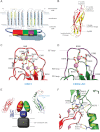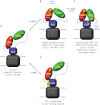Ca2+ regulation of ion transport in the Na+/Ca2+ exchanger
- PMID: 22822067
- PMCID: PMC3442498
- DOI: 10.1074/jbc.R112.353573
Ca2+ regulation of ion transport in the Na+/Ca2+ exchanger
Abstract
The binding of Ca(2+) to two adjacent Ca(2+)-binding domains, CBD1 and CBD2, regulates ion transport in the Na(+)/Ca(2+) exchanger. As sensors for intracellular Ca(2+), the CBDs form electrostatic switches that induce the conformational changes required to initiate and sustain Na(+)/Ca(2+) exchange. Depending on the presence of a few key residues in the Ca(2+)-binding sites, zero to four Ca(2+) ions can bind with affinities between 0.1 to 20 μm. Importantly, variability in CBD2 as a consequence of alternative splicing modulates not only the number and affinities of the Ca(2+)-binding sites in CBD2 but also the Ca(2+) affinities in CBD1.
Figures



Similar articles
-
Ca2+ regulation in the Na+/Ca2+ exchanger features a dual electrostatic switch mechanism.Proc Natl Acad Sci U S A. 2009 Aug 25;106(34):14333-8. doi: 10.1073/pnas.0902171106. Epub 2009 Aug 10. Proc Natl Acad Sci U S A. 2009. PMID: 19667209 Free PMC article.
-
Ca(2+) regulation in the Na(+)/Ca (2+) exchanger features a dual electrostatic switch mechanism.Adv Exp Med Biol. 2013;961:27-33. doi: 10.1007/978-1-4614-4756-6_3. Adv Exp Med Biol. 2013. PMID: 23224867 Review.
-
Crystal structure of CBD2 from the Drosophila Na(+)/Ca(2+) exchanger: diversity of Ca(2+) regulation and its alternative splicing modification.J Mol Biol. 2009 Mar 20;387(1):104-12. doi: 10.1016/j.jmb.2009.01.045. Epub 2009 Jan 29. J Mol Biol. 2009. PMID: 19361442
-
Roles of two Ca2+-binding domains in regulation of the cardiac Na+-Ca2+ exchanger.J Biol Chem. 2009 Nov 20;284(47):32735-41. doi: 10.1074/jbc.M109.055434. Epub 2009 Oct 2. J Biol Chem. 2009. PMID: 19801651 Free PMC article.
-
Structural studies of the Ca(2+) regulatory domain of Drosophila Na(+)/Ca (2+) exchanger CALX.Adv Exp Med Biol. 2013;961:55-63. doi: 10.1007/978-1-4614-4756-6_6. Adv Exp Med Biol. 2013. PMID: 23224870 Review.
Cited by
-
The properties, distribution and function of Na(+)-Ca(2+) exchanger isoforms in rat cutaneous sensory neurons.J Physiol. 2014 Nov 15;592(22):4969-93. doi: 10.1113/jphysiol.2014.278036. Epub 2014 Sep 19. J Physiol. 2014. PMID: 25239455 Free PMC article.
-
Host Plant Modulated Physio-Biochemical Process Enhances Adaptive Response of Sandalwood (Santalum album L.) under Salinity Stress.Plants (Basel). 2024 Apr 22;13(8):1162. doi: 10.3390/plants13081162. Plants (Basel). 2024. PMID: 38674572 Free PMC article.
-
Repetitive pulsed-wave ultrasound stimulation suppresses neural activity by modulating ambient GABA levels via effects on astrocytes.Front Cell Neurosci. 2024 Mar 27;18:1361242. doi: 10.3389/fncel.2024.1361242. eCollection 2024. Front Cell Neurosci. 2024. PMID: 38601023 Free PMC article.
-
Modulation of the cardiac Na+-Ca2+ exchanger by cytoplasmic protons: Molecular mechanisms and physiological implications.Cell Calcium. 2020 May;87:102140. doi: 10.1016/j.ceca.2019.102140. Epub 2019 Dec 11. Cell Calcium. 2020. PMID: 32070924 Free PMC article. Review.
-
Sodium-Calcium Exchangers of the SLC8 Family in Oligodendrocytes: Functional Properties in Health and Disease.Neurochem Res. 2020 Jun;45(6):1287-1297. doi: 10.1007/s11064-019-02949-4. Epub 2020 Jan 11. Neurochem Res. 2020. PMID: 31927687 Free PMC article. Review.
References
-
- Blaustein M. P., Lederer W. J. (1999) Sodium/calcium exchange: its physiological implications. Physiol. Rev. 79, 763–854 - PubMed
-
- Philipson K. D., Nicoll D. A. (2000) Sodium/calcium exchange: a molecular perspective. Annu. Rev. Physiol. 62, 111–133 - PubMed
-
- Annunziato L., Pignataro G., Di Renzo G. F. (2004) Pharmacology of brain Na+/Ca2+ exchanger: from molecular biology to therapeutic perspectives. Pharmacol. Rev. 56, 633–654 - PubMed
-
- Lytton J. (2007) Na+/Ca2+ exchangers: three mammalian gene families control Ca2+ transport. Biochem. J. 406, 365–382 - PubMed
Publication types
MeSH terms
Substances
LinkOut - more resources
Full Text Sources
Molecular Biology Databases
Research Materials
Miscellaneous

